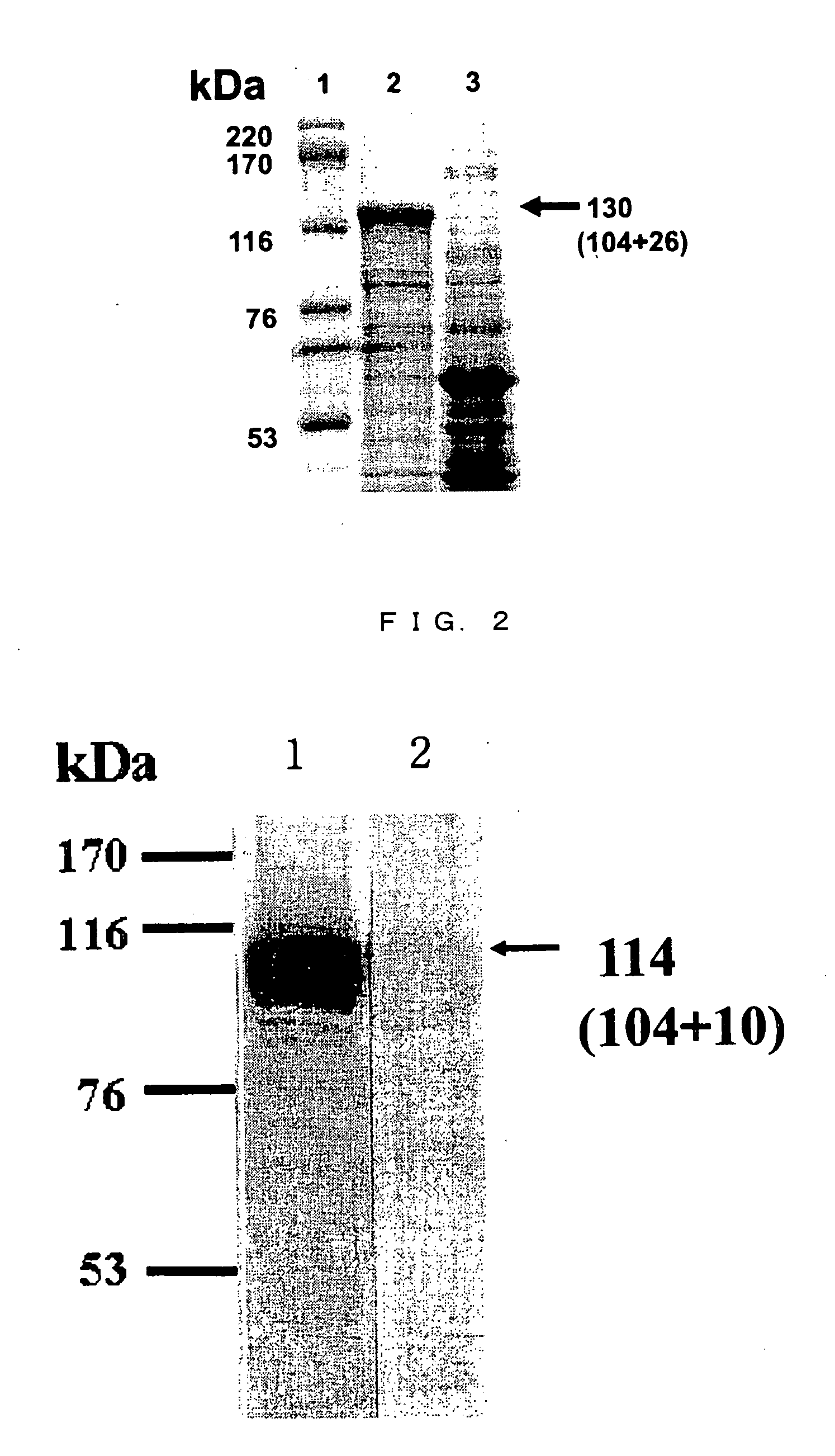Tick chitinase
a technology of chitinase and ticks, which is applied in the field of tick chitinase, can solve the problems of increasing the threat of emerging and re-emerging zoonotic diseases of ticks, increasing the damage to animals or humans, and increasing the risk of tick bites,
- Summary
- Abstract
- Description
- Claims
- Application Information
AI Technical Summary
Benefits of technology
Problems solved by technology
Method used
Image
Examples
example 1
Isolation of a Gene Encoding a Novel Tick Chitinase
[0075] Total RNA was extracted from eggs of a Haemaphysalis longicornis Okayama strain [Fujisaki et al., Nat. Inst. Anim. Hlth Quart. (Tokyo), 16, 122-128 (1976)] by an Acid Guanidinium-phenol-chloroform method [Chomczynski et al., Anal. Biochem., 162, 156-159 (1987)]. From the resulting total RNA, poly A+ RNA was purified using an mRNA isolation kit [Oligotex-dT30 (Super), code W9021B; Takara] in accordance with a protocol attached to the kit.
[0076] The following procedures, i.e., construction of a cDNA library, screening, and insertion into plasmid of a cDNA clone (in vivo Excision) were performed using commercially available reagent kits (Stratagen) in accordance with protocols attached thereto.
[0077] More particularly, cDNA was synthesized using 5 μg of tick mRNA as a template and a cDNA synthesis kit (ZAP-cDNA Synthesis Kit, Cat. No. 200401-5; Stratagen). The resulting cDNA was fractionated by a size fractionation with a Sep...
example 2
Construction of Vector for Expressing Tick Chitinase Fusion Protein
[0084] For cloning the ORF region of the tick chitinase gene, a DNA amplification was carried out by PCR using the cDNA clone obtained in Example 1 as a template, and a sense primer (consisting of the base sequence of SEQ ID NO: 3 and containing the EcoRI recognition site “gaattc” at the 5′ terminus) and an antisense primer (consisting of the base sequence of SEQ ID NO: 4 and containing the XhoI recognition site “ctcgag” at the 5′ terminus). In the PCR, 50 μL of a reaction liquid [template DNA 1 μg, 0.1 μmol / L primer, 10 mmol / L Tris-HCl (pH8.3), 50 mmol / L KCl, 1.5 mmol / L MgCl2, and 2.5U Taq Gold DNA polymerase (Part No. N808-0244; Perkin Elmer)] was used, and a cycle composed of treatments at 94° C. for 1 minute, 50° C. for 1 minute, and 72° C. for 2 minutes was repeated 40 times.
[0085] The PCR product was treated with phenol / chloroform, collected by an ethanol precipitation method, and dissolved in distilled water...
example 3
Expression of Tick Chitinase Recombinant Protein in Escherichia coli
[0088]Escherichia coli JM109 (DE3) (Promega) was transformed with the recombinant plasmid prepared in Example 2, and then the transformants were cultured at 37° C. in an LB medium containing ampicillin. When OD600nm of the culture became 0.3˜0.5, isopropyl-thio-galactoside (IPTG) was added to the culture so that the final concentration became 0.5 mmol / L, and then the transformants were further cultured at 37° C. for 4 hours.
[0089] The expression of tick chitinase recombinant protein was confirmed by carrying out 10% sodium dodecyl sulfate(SDS)-polyacrylamide gel electrophoresis [Laemmli et al., Nature, 227, 680-685 (1970)] followed by Coomassie staining.
[0090] As a result, the expression of the recombinant protein having a molecular weight of approximately 130 kDa was observed, and it was confirmed that the recombinant protein was a fusion protein of a GST leader protein (26 kDa) and the tick chitinase protein (1...
PUM
| Property | Measurement | Unit |
|---|---|---|
| Fraction | aaaaa | aaaaa |
Abstract
Description
Claims
Application Information
 Login to View More
Login to View More - R&D
- Intellectual Property
- Life Sciences
- Materials
- Tech Scout
- Unparalleled Data Quality
- Higher Quality Content
- 60% Fewer Hallucinations
Browse by: Latest US Patents, China's latest patents, Technical Efficacy Thesaurus, Application Domain, Technology Topic, Popular Technical Reports.
© 2025 PatSnap. All rights reserved.Legal|Privacy policy|Modern Slavery Act Transparency Statement|Sitemap|About US| Contact US: help@patsnap.com

